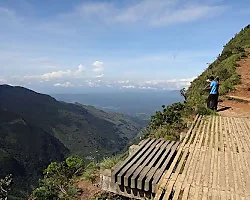
Nestled in the central highlands of Sri Lanka, Horton Plains National Park stands as a mesmerizing testament to the island nation’s diverse and stunning natural beauty. Covering an expanse of approximately 31 square kilometers, this biodiverse park is renowned for its rolling hills, deep valleys, gushing waterfalls, and unique flora and fauna. Situated in the Nuwara Eliya District of the Central Province, Horton Plains National Park is not only a sanctuary for wildlife but also a critical watershed for the major rivers that sustain the surrounding agricultural communities. In this essay, we will explore the historical significance, geographical features, biodiversity, conservation efforts, and visitor experiences that make Horton Plains a cherished and protected national treasure.
The history of Horton Plains dates back centuries, with evidence of human presence in the region found in ancient rock inscriptions and artifacts. The area was once a hunting ground for the ancient Sinhalese kings, and later, during British colonial rule, it served as a favored destination for leisurely outings among British officials and planters.
Despite its early human interactions, Horton Plains remained largely untouched and undiscovered by the outside world until the late 19th century. The British government recognized the area’s ecological importance and declared it a forest reserve in 1873. In 1988, the reserve was elevated to national park status due to its exceptional biodiversity and the need for conservation.
Horton Plains National Park sits at an elevation of 2,100 to 2,300 meters above sea level, making it one of the highest plateaus in Sri Lanka. The park’s landscape is characterized by undulating grasslands, misty mountains, and rocky outcrops. Several rivers, including the Belihul Oya, the Mahaweli River, and the Walawe River, originate within the park’s boundaries, making it a vital catchment area for the island’s major waterways.
The most iconic geological feature of Horton Plains is undoubtedly World’s End. This sheer cliff plunges more than 870 meters into the valley below, offering visitors breathtaking views of the lowlands and the distant southern coastline. Nearby, Baker’s Falls cascades down a rock face, providing a refreshing respite and adding to the park’s enchanting allure.
Horton Plains is a biodiversity hotspot, boasting a remarkable array of flora and fauna that have evolved over millennia in isolation. The park’s unique ecosystems range from cloud forests to grasslands, each supporting its own specialized plant and animal species.
The montane evergreen cloud forests are home to a variety of endemic trees and shrubs, including the elusive Horton Plains slender loris and purple-faced langur, both of which are endangered. The park also provides a sanctuary for numerous bird species, such as the Sri Lanka bush warbler, the Sri Lanka white-eye, and the Sri Lanka blue magpie.
Horton Plains is particularly famous for its floral diversity. Some of Sri Lanka’s most celebrated endemic plant species, such as the Horton Plains mahogany, the Dendrobium maccarthiae orchid, and the Rhododendron arboreum subsp. zeylanicum, can be found thriving in this unique ecosystem.
Recognizing the ecological significance of Horton Plains, the Sri Lankan government, in collaboration with various conservation organizations, has taken substantial measures to protect and preserve the park’s delicate ecosystems. Strict regulations and guidelines are enforced to control visitor numbers and maintain the park’s pristine conditions.
In recent years, reforestation initiatives have been undertaken to restore degraded areas, and community-based conservation programs have been established to involve local communities in safeguarding the park’s biodiversity. Furthermore, ongoing research and monitoring are conducted to better understand the park’s ecosystems and make informed conservation decisions.
Horton Plains offers a range of unforgettable experiences for nature enthusiasts and adventure seekers alike. The park’s main trekking trail leads visitors through enchanting grasslands and cloud forests to the famous World’s End viewpoint. The journey, though challenging in parts, is rewarded with breathtaking vistas and encounters with unique wildlife.
Another popular trail leads to Baker’s Falls, where visitors can revel in the beauty of the cascading waterfall and immerse themselves in the tranquil surroundings. Along the way, hikers may spot various bird species and, if lucky, glimpse some of the park’s elusive mammals.
For those seeking an extra dose of adventure, Horton Plains offers opportunities for camping under the star-studded sky, allowing visitors to experience the serenity of the wilderness during the quiet hours of the night.
Horton Plains National Park stands as a testament to Sri Lanka’s commitment to preserving its natural heritage. With its stunning geographical features, unparalleled biodiversity, and rich historical significance, the park continues to captivate the hearts of both local and international visitors.
Through dedicated conservation efforts, Horton Plains remains an oasis of wilderness in a world increasingly dominated by human activity. As we move further into the 21st century, it is crucial that we continue to protect and cherish such precious natural treasures, ensuring that future generations can experience the magic and wonder of places like Horton Plains National Park

OURA Travel operates with the utmost dedication to offering exceptional experiences. While we endeavor to ensure accurate and enjoyable tours, our services are subject to availability and may change without prior notice. We bear no liability for unforeseen circumstances, injuries, or loss during the tours. Booking confirmation is contingent upon availability and adherence to our specific booking conditions, including terms and cancellation policies. Participants are advised to meet health requirements for travel, as we disclaim liability for issues arising from health or fitness limitations. Additionally, our descriptions are aimed at accuracy, although errors may occur, and we reserve the right to rectify any information or pricing inaccuracies.